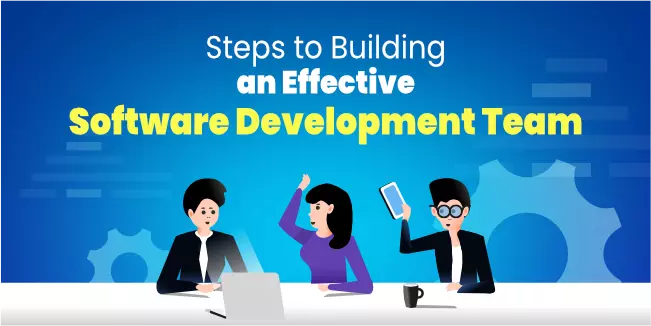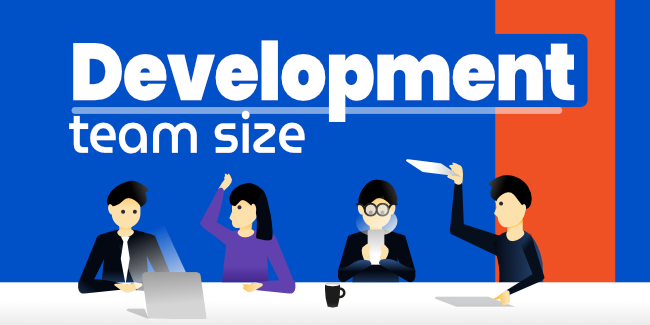development
softwaredevelopment
Steps to Building an Effective Software Development Team

Define the kind of development team type that fits your project
Let's start with the fundamentals. There are three types of Agile software development teams - generalists, specialists, and hybrids. You must choose the sort of team you wish to form before we go deeper into what to consider while creating a development team. Creating a clear software development team structure is an essential first step toward project success overall.
Generalists
The "generalist" team comprises individuals with various talents and experience. It's the most frequent outsourcing company project team structure. Such teams are generally in charge of the whole project's or individual features end-to-end development. The pros of a generalist approach are that every team member understands the product well enough to focus on improving it. Each individual is competent enough to do their job without relying on others. On the other hand, the generalist approach has negatives too. Because no one has comprehensive knowledge, it's sometimes necessary to integrate a new employee into the middle of a project.
Specialists
A product team structure with a "specialist" approach has highly skilled specialists performing limited operations. Everyone's an expert in their field, so they are entirely responsible for their portion of the project. Software development teams frequently use this sort of system.
Experts in construction and architecture can provide comprehensive, specialized services. The development team has a deep understanding of all project elements and can quickly develop sophisticated, high-quality systems. Specialists working independently can have disadvantages, such as the risk that the components will not fit at first if everyone is working alone. There may be communication gaps owing to a lack of overall understanding.
Hybrid team
A “hybrid" project team structure is simply a mix of generalists and specialists. These teams operate on a project as a whole, but they may focus their efforts when necessary.
Some specialists create distinct components and generalists who ensure that the system is integrated using this method. The project approach is highly successful. Cons It may be tough to bring together people with various workflows. Coordinating a team that includes individuals from different parts of the organization is time-consuming and expensive.
Decide on the software development team size
Depending on the project, you'll need many people on your software development team. A group of three or five may be enough for modest projects, but larger ones might require a crew of 10 or more. Consider the following points while deciding how big your software development team should be:
- The complexity of the project
- The skill set required for the project
- How much experience the team has with the technology being used
- Budget
- Deadline
- Available resources

Based on these essential factors, you can decide what kind of team size your solution requires. According to the Scrum method, the ideal team size is between 3 and 9 people, with 7 being the most suitable. However, that is not to say that you must stick to this guideline. Suppose your software project requires a more significant number of people. In that case, it does not imply that you will face difficulties in controlling it or establishing communication. The key is to carefully manage your team in keeping with your project's demands.
Agile Team vs. Traditional Team
Agile teams have a few more job responsibilities on the surface. But let's think about the Agile Manifesto for a moment.
Individuals and interactions take precedence over processes and tools. Over-engineered, over-written programs are a waste of money and time. There's no reason to have everything on paper when you can get the job done with working software. Over contract negotiation, customer collaboration prevails. Overcoming change rather than following a strategy. The fundamental distinction between a conventional and an Agile team structure is how teammates interact with one another.
Traditional Team
Project management is a top-down approach. The project manager has the authority to execute activities. Several projects may be worked on at the same time by teams. An organization measures individual success. There are many job titles and tasks to fulfill. Teams have no such restrictions imposed upon them.
Agile Team
A team with a high degree of self-direction and self-management. The PM's job is to inspire, clear obstructions, and avoid distractions for the group. Teams work on a single project at any one moment. Each team has three to nine members. Titles are less important than skills in cross-functional teams.
Establish clear roles and goals
This one appears to be self-evident: the roles inside your team are straightforward. Are you sure there aren't any designers, coders, or testers? Perhaps a designer and a developer, but not necessarily so. The real roles of an effective software development team are more varied and intricate than that.

Now let’s look more closely into each of the software development team structures and team roles:
Frontend
The frontend software developer designed every element they saw on the client's website. I believe it's sufficient to persuade you of the significance of their role in the product development software team structure. They ensure that your customers have an easy, trouble-free experience. The most challenging aspect of their job is to ensure that all users receive the same experience — whether they're using Edge, Chrome, a computer, an Android phone, or an iOS device. It's a huge task considering how many browsers, cell phones, smartwatches, and other smart stuff we manage. Frontend developers are expected to be browser charmers and resolution experts. We would have to operate in the command line on black-and-white displays if we didn't have them.
Backend
The primary function of the backend software engineer in a software development team is to be a Problem Solver. The person who creates complex and sophisticated machine code that powers all the magic from behind the scenes. Backend developers ensure that your product not only looks good but also runs efficiently and robustly. Backend developers, on the other hand, are often neglected. They design and build the application's architecture, including deciding which services and databases should communicate and how APIs and external connections should function. Rather than being coders who produce code, backend developers are consultants who plan and develop an application's architecture. A competent backend developer not only follows instructions but also seeks for the most effective technique to address a problem.
QA
Even the most skilled software developer isn't capable of producing flawless solutions on their own, so every software development team may benefit from having a Quality Assurance Engineer on board. QA experts are responsible for identifying bugs and problems before your consumers do. While testing your application, a QA specialist pays attention to performance, assurance, user-friendliness, portability, and the application's appearance from the end-user viewpoint. They're not simply testers; they ensure that the features are working, document them, generate test cases, and actively contribute to raising project development standards. The role of a project manager is essential in delivering a high-quality product, providing a smooth end-user experience, and executing project objectives.
DevOps
DevOps Engineers are responsible for taking your infrastructure to the next level. Their specialty is infrastructure as code, automated processes, scalable, robust, and tailored cloud solutions. They ensure that your application is quick, secure, and available to people worldwide. Your app must be able to handle sudden increases in usage without being overloaded. It must stay online even if the entire server warehouse flames.
Product Designer
They're called Product Designers for a reason. They work with both software and non-software product development teams. They may be known as UX designers, UI designers, information architects, user pleasers, etc. Product Designers are crucial players in the success of your product. Graphic artists who create attractive designs are what most people think of when they hear the term "product designer." Designers ensure that the sensation and appearance of your product and the overall user interface, are as sharp and appealing as possible. They'll work with you throughout the whole development process, from translating your company's goals into useful user experiences to evaluating, rating, and evolving them over time. They are also experts in data, which surprises many people. They notice every change in conversion rates, click rates, and so on and draw conclusions before proposing remedies to ensure that your metrics support your company goals. Product designers are critical members of any development team who aiming to entice consumers to fall in love with its products and ultimately convert through sales funnels.
Product Owner
The product owner is usually a key stakeholder of the initiative. It is someone who has significant expertise in both the user and product areas and is in charge of the internal development process. Their responsibility is to ensure that the completed product/service meets the client's needs. PO keeps an eye on the team, helps them execute their tasks, and makes sure that all product criteria are satisfied.
Scrum Master
Let's start by describing Scrum. It's a method for agile teams to self-organize and adapt to changes according to the Agile development principles. The Scrum master is the process owner who oversees the team's activities. He helps the team by facilitating and managing everything that happens on it.
Project Manager
Project managers ensure that the project is on track, which can be difficult for IT software development. They ensure that the team is driven and highly productive, that risks are identified and managed, and that strict development and communication standards are maintained. Between the world of business difficulties and technical jargon, project management acts as a link.

A Project Manager has a unique viewpoint on the product and process since he or she is simultaneously working for both sides as a consultant: one foot in the software development team and the other on the business side. A Project Manager ensures that an issue is fixed promptly and, if feasible, prevented from recurring when something unexpected occurs, such as a team member becoming ill or the application not functioning. They also constantly look at the whole development process and its stages and areas for improvement, to ensure that the team generates more value faster in each iteration. Having appropriate project management in your crew allows you to focus on your product and company instead of keeping track of every little detail.
Business Analyst
Not because they were poorly built, but rather due to a lack of product-market fit, over 80% of the goods fail. A Business Analyst ensures that you develop the appropriate product at the correct time to address the proper problem and agree with your company's strategy and client's expectations. A Business Analyst works with you to establish a product vision and develop requirements based on your consumers' and stakeholders' demands, then assists in the validation of your progress.
The effective software development team
There are a few different structures within software development teams. Still, most commonly, there is a project manager, developers, and testers. The project manager is responsible for the overall project and ensuring it is completed on time and within budget. Developers write the code for the software, and testers test it to ensure that it works properly.
The structure of your team will largely depend on the size of your company and the type of product you are developing. If you are a small company with limited resources, you may need these roles in-house. However, if you are a large company with multiple products, you may outsource some or all of these roles.
No matter what structure you choose, it is crucial to have a clear hierarchy and communication channels so that everyone knows their role and can work together effectively. It is important to find the right skills and personalities when assembling your team.You need developers who are experts in coding, testers who are detail-oriented and able to think outside the box, and a project manager who can keep everything on track.

It is also essential to have a good working relationship among team members. It will help ensure that everyone can work productively together. If there is tension or conflict, it can be challenging to get anything done. There's no way to become a successful company with a mediocre team. As a result, the biggest issue for every business is to guarantee that its employees are inspired and performing at their peak. While virtually everyone can discover competent personnel, not every firm can create empowering collaborative environments for its teams to thrive.
Communication
Communication is at the core of every type of collaboration, regardless of industry. Software development is no exception. People in excellent teams have the required tools and processes for routine, productive communication.
Clear vision and mission
Teams that succeed don't need tight top-down management. They have clear objectives and a shared objective. In such an atmosphere, the team's success is seen as each member's.
Well-defined responsibilities and roles
While the team's objective is the same, each member understands exactly what needs to be done to bring it about. From the start, expectations, roles, and responsibilities are established. People are held responsible for making progress by one another due to their shared goals.
Strong bond
A good culture is one in which employees have a strong sense of belonging and support and a feeling of ease among each other. Such groups enjoy spending time together at work and away from it.
Conclusion
The most important element in a project's success is determining the type of team you want to form. Whether it should be made up of experts with considerable expertise in their area, generalists who have some knowledge in many disciplines, or a combination of both. Once you've decided on a development approach, it's time to figure out how big your team will be. Keeping in mind what your decision entails, determine the size of your team. Establish software development team roles and what is required of each person after you've organized your staff. However, remember that a successful team is one with established clear communication channels and a productive work style.
We have been dealing with this issue for many years as a software development company. This entire article is based on our experience and best practices that we use in our daily work with clients. If you want to discuss your software project, arrange a free consultation, during which we will share our knowledge and experience.